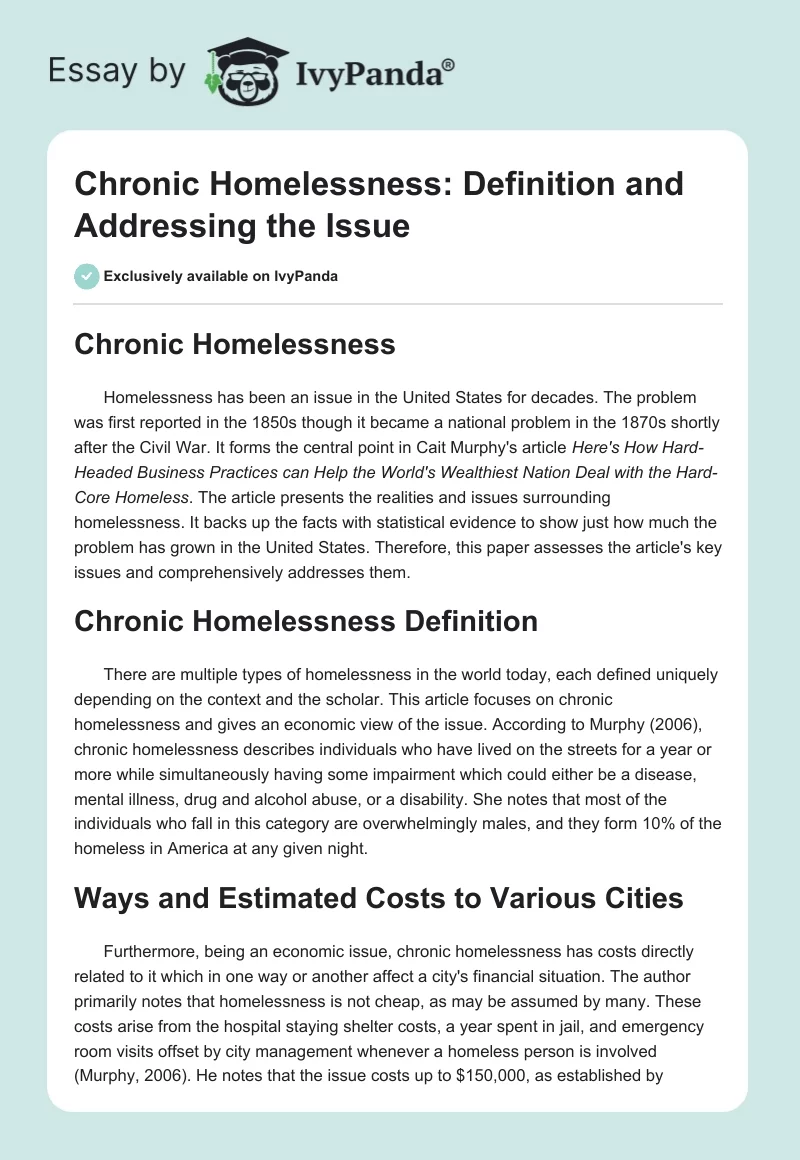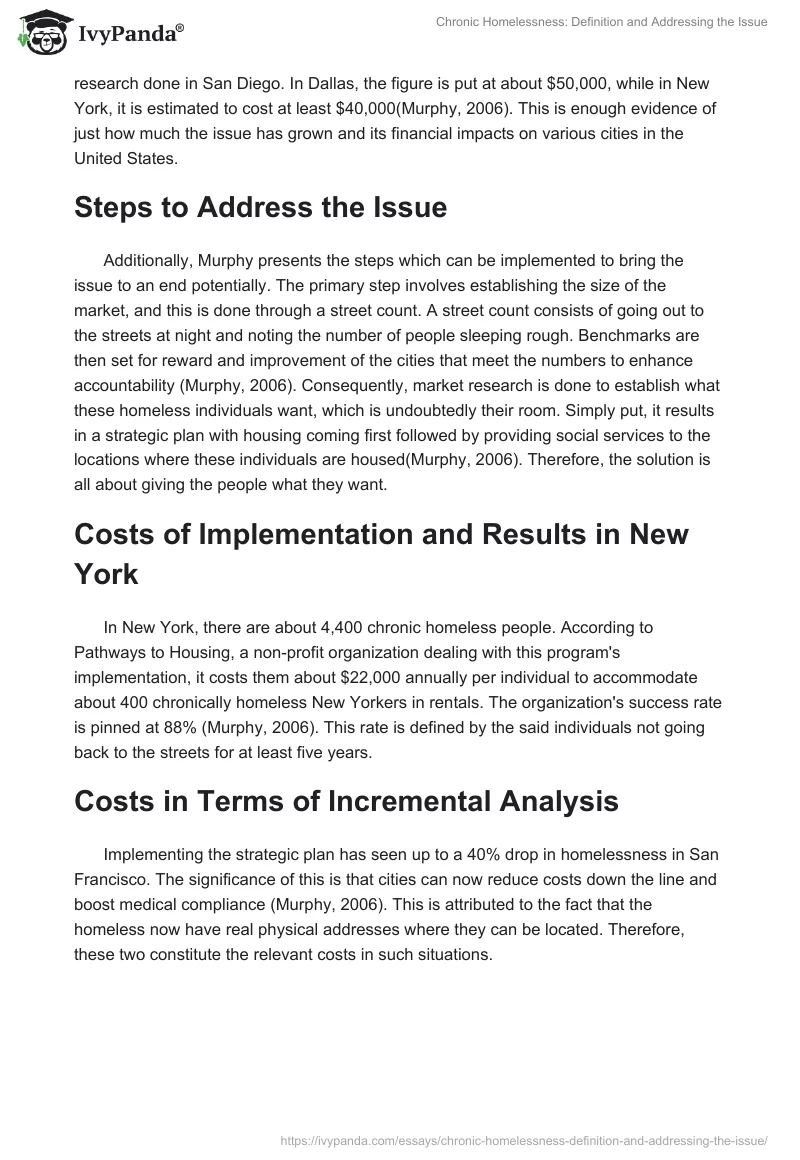Chronic Homelessness
Homelessness has been an issue in the United States for decades. The problem was first reported in the 1850s though it became a national problem in the 1870s shortly after the Civil War. It forms the central point in Cait Murphy’s article Here’s How Hard-Headed Business Practices can Help the World’s Wealthiest Nation Deal with the Hard-Core Homeless. The article presents the realities and issues surrounding homelessness. It backs up the facts with statistical evidence to show just how much the problem has grown in the United States. Therefore, this paper assesses the article’s key issues and comprehensively addresses them.
Chronic Homelessness Definition
There are multiple types of homelessness in the world today, each defined uniquely depending on the context and the scholar. This article focuses on chronic homelessness and gives an economic view of the issue. According to Murphy (2006), chronic homelessness describes individuals who have lived on the streets for a year or more while simultaneously having some impairment which could either be a disease, mental illness, drug and alcohol abuse, or a disability. She notes that most of the individuals who fall in this category are overwhelmingly males, and they form 10% of the homeless in America at any given night.
Ways and Estimated Costs to Various Cities
Furthermore, being an economic issue, chronic homelessness has costs directly related to it which in one way or another affect a city’s financial situation. The author primarily notes that homelessness is not cheap, as may be assumed by many. These costs arise from the hospital staying shelter costs, a year spent in jail, and emergency room visits offset by city management whenever a homeless person is involved (Murphy, 2006). He notes that the issue costs up to $150,000, as established by research done in San Diego. In Dallas, the figure is put at about $50,000, while in New York, it is estimated to cost at least $40,000(Murphy, 2006). This is enough evidence of just how much the issue has grown and its financial impacts on various cities in the United States.
Steps to Address the Issue
Additionally, Murphy presents the steps which can be implemented to bring the issue to an end potentially. The primary step involves establishing the size of the market, and this is done through a street count. A street count consists of going out to the streets at night and noting the number of people sleeping rough. Benchmarks are then set for reward and improvement of the cities that meet the numbers to enhance accountability (Murphy, 2006). Consequently, market research is done to establish what these homeless individuals want, which is undoubtedly their room. Simply put, it results in a strategic plan with housing coming first followed by providing social services to the locations where these individuals are housed(Murphy, 2006). Therefore, the solution is all about giving the people what they want.
Costs of Implementation and Results in New York
In New York, there are about 4,400 chronic homeless people. According to Pathways to Housing, a non-profit organization dealing with this program’s implementation, it costs them about $22,000 annually per individual to accommodate about 400 chronically homeless New Yorkers in rentals. The organization’s success rate is pinned at 88% (Murphy, 2006). This rate is defined by the said individuals not going back to the streets for at least five years.
Costs in Terms of Incremental Analysis
Implementing the strategic plan has seen up to a 40% drop in homelessness in San Francisco. The significance of this is that cities can now reduce costs down the line and boost medical compliance (Murphy, 2006). This is attributed to the fact that the homeless now have real physical addresses where they can be located. Therefore, these two constitute the relevant costs in such situations.
Related Articles
This issue has been addressed by several other authors and researchers looking at its different aspects. One such article published in 2020 is Homeless in America by Joseph S. Alpert. The author notes that there are more homeless people in California than in his hometown, Tucson, according to what he witnessed on a trip he had with his spouse to the city. Furthermore, he acknowledges that many of these people suffer from various conditions such as respiratory illness, mental illness, addiction, and cellulitis (Alpert, 2020). His experience as a doctor has shown him that most of the homeless also suffer from malnutrition, and most of the time, they sign out of hospitals against medical advice. Moreover, the article provides some of the characteristics of homelessness, including a definition of the issue and statistics concerning prevalence rates over the years (Alpert, 2021). The author also notes some of the programs solving the issue, such as the Housing First Model, which hoses those with mental disorders or addiction.
Another article, Changes in Physical Health after Supported Housing: Results from the Collaborative Initiative to End Chronic Homelessness, by Jack Tsai et al. (2019) also discusses some of these issues. It looks at the association between housing status, physical health, and trust in care providers as a way to examine the chronic homeless physical health changes after participation in supported housing programs (Tsai et al., 2019). The study was done every three months for a year across 11 sites for a total of 756 chronically homeless adults (Tsai et al., 2019). However, it notes no association between medical outcomes and improved housing status, including health-related quality of life.
References
Alpert, J. (2020). Homeless in America.The American Journal of Medicine, 134(3), 295-296. Web.
Murphy, C. (2006). The toughest customers: How hard-headed business metrics can help the hard-core homeless. Fortune Magazine.
Tsai, J., Gelberg, L., & Rosenheck, R. (2019). Changes in physical health after supported housing: Results from the collaborative initiative to end chronic homelessness.Journal of General Internal Medicine, 34(9), 1703-1708. Web.


